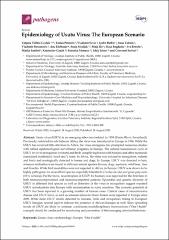| dc.description.abstract | Usutu virus (USUV) is an emerging arbovirus isolated in 1959 (Usutu River, Swaziland).
Previously restricted to sub-Saharan Africa, the virus was introduced in Europe in 1996. While the
USUV has received little attention in Africa, the virus emergence has prompted numerous studies
with robust epidemiological surveillance programs in Europe. The natural transmission cycle of
USUV involves mosquitoes (vectors) and birds (amplifying hosts) with humans and other mammals
considered incidental (“dead-end”) hosts. In Africa, the virus was isolated in mosquitoes, rodents
and birds and serologically detected in horses and dogs. In Europe, USUV was detected in bats,
whereas antibodies were found in different animal species (horses, dogs, squirrels, wild boar, deer
and lizards). While bird mortalities were not reported in Africa, in Europe USUV was shown to be
highly pathogenic for several bird species, especially blackbirds (Turdus merula) and great gray owls
(Strix nebulosa). Furthermore, neurotropism of USUV for humans was reported for the first time in
both immunocompromised and immunocompetent patients. Epizootics and genetic diversity of
USUV in different bird species as well as detection of the virus in mosquitoes suggest repeated
USUV introductions into Europe with endemization in some countries. The zoonotic potential of
USUV has been reported in a growing number of human cases. Clinical cases of neuroinvasive
disease and USUV fever, as well as seroconversion in blood donors were reported in Europe since
2009. While most USUV strains detected in humans, birds and mosquitoes belong to European
USUV lineages, several reports indicate the presence of African lineages as well. Since spreading
trends of USUV are likely to continue, continuous multidisciplinary interventions (“One Health”
concept) should be conducted for monitoring and prevention of this emerging arboviral infection. | en_US |
| dc.description.sponsorship | This work was supported by the Croatian Science Foundation, project no. IP 2016–06-7456: "Prevalence and molecular epidemiology of emerging and re-emerging neuroinvasive arboviral infections in Croatia"; CRONEUROARBO (to TVC), by a bilateral project funded by Croatian Ministry of Science and Education and Serbian Ministry of Education, Science and Technological Development: "Optimization of diagnosis and surveillance of emerging and re-emerging viral vector-borne zoonoses" (to LjB and TP), and by project No.
TR31084 funded by the Serbian Ministry of Education, Science and Technological Development. | en_US |

